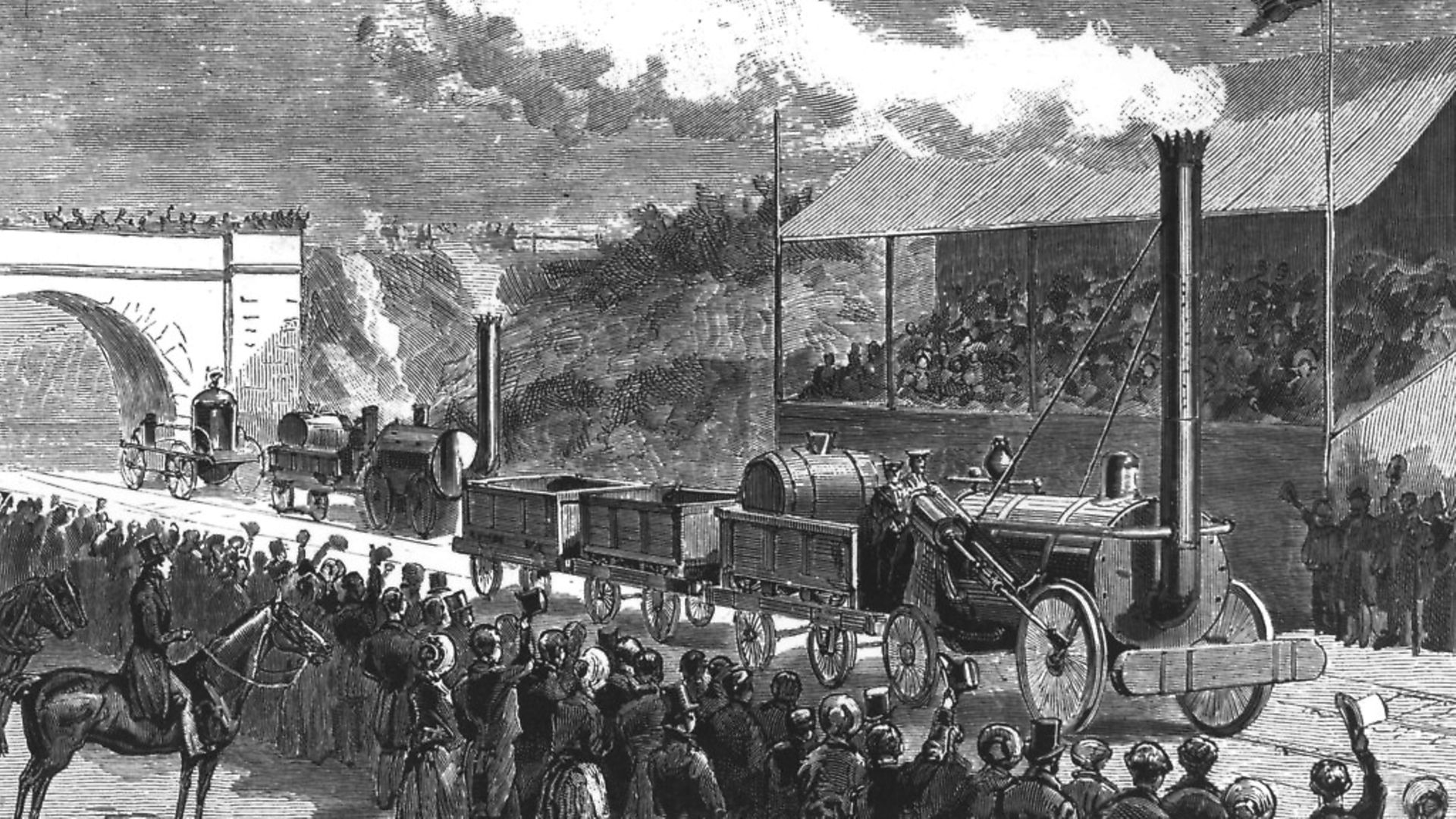
Ahead of its 200th anniversary, MICK O’HARE re-evaluates the Rainhill Trials, the competition that kick-started the modern era.
Just off St James’s Place in central London is the bar at Dukes Hotel once frequented by, among others, James Bond creator Ian Fleming. It’s celebrated for its undiluted martinis, so alcohol-laden that patrons are (most politely) restricted to two in any one visit. Just behind the bar is a house that Winston Churchill briefly lived in as a child. And next door to Churchill’s house is the former home of Tory politician William Huskisson. Yet, despite being the least famous of the three neighbours, Huskisson holds a special place in history. In 1830, he was the first man to be killed by a train – more of that later. And that train was the now-famous Rocket, designed by George Stephenson, which one year earlier had won the Rainhill Trials.
Now even more of a footnote in railway history than poor Huskisson’s demise, the Rainhill Trials were a big deal at the time. The Industrial Revolution was at its height, the populations of northern England’s major cities were booming, as was production and trade. And all that, of course, required mass transport.
The world’s first intercity railway, the Liverpool and Manchester – built to connect the cotton mills of the latter with the docks of the former – was nearing completion in 1829. Its directors had initially intended to use stationary steam engines to haul cables attached to the trains. But Stephenson had been appointed the Liverpool and Manchester’s engineer three years earlier and he had a different idea. His plan was to use locomotives instead which would travel up and down the line under their own steam power. Yet he needed to convince the directors.
Stephenson was respected by his employers but they wanted proof. Hence the Rainhill Trials. Designers of steam locomotives were invited to win a prize of £500 (worth getting on for 100 times that amount today) to first prove that standalone locomotives were a better option than cable-hauled trains, and if so which of them could build the best.
The British of the 19th century loved codifying sports (football, rugby and hockey were all turned into official games in the 1800s), and so it was with their railway competition. The rules were strict. No locomotive could weigh more than six tons, it had to haul three times its own weight and cost less than £550 to build (they were thrifty too – the directors realised they would be footing the bill for the new line’s fleet).
The wheels had to be sprung – passengers would not pay for a bumpy ride – and nor would they pay for a slow one: the train had to reach a speed of at least 10mph. The directors also realised passengers (who were likely to be out in the open) might not mind a spot of rain or a chilly journey but would not want their finery dusted in soot – crucially the engine had to “effectively consume its own smoke”.
The line near the hamlet of Rainhill, ten miles east of Liverpool, was chosen for the trials because it was dead flat. They started on October 6 and ran for six days. There had been 10 entries for the contest but only five made it to the starting line – as did an astounding 10,000 spectators, showing both “the beauty and fashion of the neighbourhood” and a great many reporters.
Very few people had ever seen a locomotive and the local pubs did great business. Local Quakers were also in attendance, apparently unimpressed by the steam engines’ ability to interfere with their direct experience with God. They were to be disappointed – over the coming years God was to prove he was quite the railway enthusiast. As the Times reported: “Never, perhaps, were so many scientific gentlemen and practical engineers collected together at one spot as there were on the rail-road.”
The locomotives had to make trips up and down the section of the line to simulate the distance between Liverpool and Manchester before refuelling. Stephenson and the railway directors had expected all the entries to be steam-powered but Thomas Brandreth’s Cycloped was driven by a horse walking along a drive belt. It failed to reach more than 5mph and when the horse fell through the bottom it was withdrawn. Rather rudely it was described as “an absurd affair”.
Another retirement was Timothy Burstall’s rather ill-named Perseverance. He had brought his locomotive all the way from Leith, near Edinburgh. The luckless Burstall suffered a mishap even before arriving, when his engine fell from the wagon transporting it to Rainhill, and he spent the first five days repairing it. It finally ran on the last day but no faster than 6mph. Taking pity, the judges gave the forlorn engineer £25 to cover his travel expenses.
His withdrawal left the trial down to the last three. Until now, steam locomotives had been rough and ready affairs “handicapped by being on rails never intended to bear such a weight; wheezing, leaking at every joint, and often breaking down” according to the Transactions of the Newcomen Society, on the 100th anniversary of the trials. Things were about to change.
The stand-out engine at the start of the week was The Novelty, built by Londoners John Braithwaite and John Ericsson. It was light and fast and on the first day almost reached 30mph. The crowds loved it too and it became the hot favourite among those partaking in the illicit gambling that was thriving, track-side.
One witness rather floridly described how “It [presented] one of the most sublime spectacles of mechanical ingenuity and human daring the world ever beheld. It actually made one giddy… and filled the breasts of thousands with lively fears for the safety of the individuals who were on it, and who seemed… to fly, as it were, on the wings of the wind”. Alas, the following day its boiler pipe broke. Despite their best efforts at repair, Braithwaite and Ericsson were out.
Timothy Hackworth’s Sans Pareil was actually overweight, but with successful entries clearly limited, the judges allowed it to run, and it completed eight of its trips, reaching 16mph, before it cracked a cylinder. Hackworth was not happy, the cylinder had been cast by a company owned by Robert Stephenson, the son of George, who was also present at the trials helping his father.
One witness John Dixon wrote in a letter to his brother James: “Timothy Hackworth has been sadly out of temper. He openly accused George Stephenson’s people of considering to hinder him of which I do believe them innocent.”
Was this the first instance of sour grapes over the awarding of a railway franchise? There was some compensation. Sans Pareil had done enough to attract the admiration of the directors of the Bolton and Leigh Railway who hired it following the trials. It would run for two years on their railway.
Presumably the Stephensons were not too distraught over Hackworth’s ill-directed criticism because it was becoming clear that Rocket was going to be the victor, as its rivals fell by the wayside.
With its multi-tubular boiler, it was the only locomotive to complete the trials. Driven by Jon Dewerance it managed 15mph laden, while running unladen it topped, according to some reports, 30mph. The directors of the Liverpool and Manchester Railway were convinced. George Stephenson and Rocket got the gig.
However, the Liverpool Mercury regretted the demise of the Novelty, pointing out that the London entry had probably suffered from there being no railways in the capital. How times change. But it congratulated “Mr Stephenson, with much sincerity” despite “the grand prize of public opinion [being] the one gained by Messrs Braithwaite and Ericsson”. The writer noted that Stephenson had brought “perfection” to the steam locomotive, but that the Londoners had impressed nine-tenths of the engineers and scientific men in Liverpool.
The Mechanics Magazine too was impressed by the Novelty and the Sans Pareil locomotives, feeling in the long term they would be better suited to railway haulage, but admitted that ”we do not see how the directors can in justice do otherwise than award that prize to Mr Stephenson” and commended the engineer on his “skill and ingenuity”.
Of the trials themselves the Scotsman wrote that they “will give a greater impulse to civilisation than it has ever received from any single cause since the [printing] press first opened the gates of knowledge to the human species”. It was a bold claim which, even with hindsight, would be difficult to argue against.
The Liverpool and Manchester Railway opened less than a year later, on September 15, 1830. Among the dignitaries invited were Huskisson, then a Liverpool MP, and the prime minister, the Duke of Wellington.
Eight locomotives were now running on the double-tracked railway, but although the company had made it clear it was dangerous to leave the train, rail safety was in its infancy. When Huskisson’s southbound train stopped at Parkside station he stepped onto the northbound line to speak to the prime minister through his carriage window. He heard shouting and saw a train approaching but was struck as he attempted to climb into the carriage to escape. Huskisson died later that evening. It was Rocket that had killed him.
There was irony in the tragedy. Because Huskisson was killed by the winning locomotive on the new railway, news of both became widespread. His demise actually made the line far more popular than it might otherwise have been. The engine became so famous that it still exists and will soon be on display in the National Railway Museum in York.
The Transactions of the Newcomen Society described the Rainhill Trials as one of “strength between terrifying monsters” and that “the crowds came and gaped with wonder”. But it also noted that the importance of the competition could not be overestimated. Had Rocket broken down like its rivals then almost certainly cables would have been used on the railway. Would they have been as successful? We must presume not.
Rainhill was the cradle of the railway age. The changes railways wrought reshaped society, industry and lifestyles throughout Britain and the world. They called it “Railway Mania” and it peaked in 1846 when parliament approved 272 Acts to set up new railways.
And Huskisson himself leaves us with two legacies, beyond being the first railway fatality. He has a physical memorial beside the track and a more practical one. The Manchester and Liverpool became the first railway to introduce red and green light signals to indicate whether or not it was safe for a train to proceed. Sadly, a year too late…










